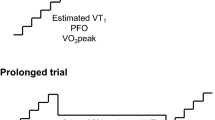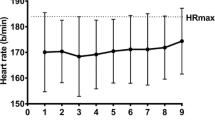Abstract
It was tested whether cyclists perform better during all-out cycling following prolonged cycling at the pedal rate resulting in minimum oxygen uptake (VO2), i.e. the energetically optimal pedal rate (OPR) rather than at the freely chosen pedal rate (FCPR). Nine trained cyclists cycled at 180 W to determine individual OPR and FCPR. Baseline performance was determined by measuring mean power output (W5min) and peak VO2 during 5-min all-out cycling at FCPR. Subsequently, on two separate days, the cyclists cycled 2.5 h at 180 W at OPR and FCPR, with each bout followed by a 5-min all-out trial. FCPR was higher (P < 0.05) than OPR at 180 W (95 ± 7 and 73 ± 11 rpm, respectively). During the prolonged cycling, VO2, heart rate (HR), and rate of perceived exertion (RPE) were 7–9% higher (P < 0.05) at FCPR than at OPR and increased (P < 0.05) 2–21% over time. During all-out cycling following prolonged cycling at OPR and FCPR, W5min was 8 and 10% lower (P < 0.05) than at baseline, respectively. Peak VO2 was lower (P < 0.05) than at baseline only after FCPR. The all-out trial power output was reduced following 2.5 h of cycling at 180 W at both OPR and FCPR. However, this aspect of performance was similar between the two pedal rates, despite a higher physiological load (i.e. VO2, HR, and RPE) at FCPR during prolonged cycling. Still, a reduced peak VO2 only occurred after cycling at FCPR. Therefore, during prolonged sub-maximal cycling, OPR is at least as advantageous as FCPR for performance optimization in subsequent all-out cycling.



Similar content being viewed by others
References
Baldwin J, Snow RJ, Gibala MJ, Garnham A, Howarth K, Febbraio MA (2003) Glycogen availability does not affect the TCA cycle or TAN pools during prolonged, fatiguing exercise. J Appl Physiol 94:2181–2187
Borg G (1970) Perceived exertion as an indicator of somatic stress. Scand J Rehab Med 2:92–98
Brisswalter J, Hausswirth C, Smith D, Vercruyssen F, Vallier JM (2000) Energetically optimal cadence vs. freely-chosen cadence during cycling: effect of exercise duration. Int J Sports Med 21:60–64
Broker JP (2003) Cycling power: road and mountain. In: Burke ER (eds) High-tech cycling. Human Kinetics, Champaign, pp 147–174
Cairns SP, Knicker AJ, Thompson MW, Sjøgaard G (2005) Evaluation of models used to study neuromuscular fatigue. Exerc Sport Sci Rev 33:9–16
Coast JR, Welch HG (1985) Linear increase in optimal pedal rate with increased power output in cycle ergometry. Eur J Appl Physiol 53:339–342
Fitts RH (1994) Cellular mechanisms of muscle fatigue. Physiol Rev 74:49–94
Foss Ø, Hallén J (2005) Cadence and performance in elite cyclists. Eur J Appl Physiol 93:453–462
Foss Ø, Hallén J (2004) The most economical cadence increases with increasing workload. Eur J Appl Physiol 92:443–451
Green HJ, Duhamel TA, Ferth S, Holloway GP, Thomas MM, Tupling AR, Rich SM, Yau JE (2004) Reversal of muscle fatigue during 16 h of heavy intermittent cycle exercise. J Appl Physiol 97:2166–2175
Hansen EA, Andersen JL, Nielsen JS, Sjøgaard G (2002) Muscle fibre type, efficiency, and mechanical optima affect freely chosen pedal rate during cycling. Acta Physiol Scand 176:185–194
Hautier CA, Linossier MT, Belli A, Lacour JR, Arsac LM (1996) Optimal velocity for maximal power production in non-isokinetic cycling is related to muscle fibre type composition. Eur J Appl Physiol 74:114–118
Hintzy F, Belli A, Grappe F, Rouillon JD (1999) Optimal pedalling velocity characteristics during maximal and submaximal cycling in humans. Eur J Appl Physiol 79:426–432
Jeukendrup AE, Craig NP, Hawley JA (2000) The bioenergetics of World Class Cycling. J Sci Med Sport 3:414–433
Lepers R, Hausswirth C, Maffiuletti N, Brisswalter J, van Hoecke J (2000) Evidence of neuromuscular fatigue after prolonged cycling exercise. Med Sci Sports Exerc 32:1880–1886
Lucia A, Hoyos J, Carvajal A, Chicharro JL (1999) Heart rate response to professional road cycling: the Tour de France. Int J Sports Med 20:167–172
Lucia A, Hoyos J, Chicharro JL (2001) Preferred pedalling cadence in professional cycling. Med Sci Sports Exerc 33:1361–1366
Marsh AP, Martin PE (1993) The association between cycling experience and preferred and most economical cadences. Med Sci Sports Exerc 25:1269–1274
McArdle WD, Katch FI, Katch VL (2001) Exercise physiology Energy, nutrition, and human performance. Lippincott, Williams & Wilkins, Philadelphia, Baltimore, p. 183
Nielsen JS, Hansen EA, Sjøgaard G (2004) Pedalling rate affects endurance performance during high-intensity cycling. Eur J Appl Physiol 92:114–120
Noakes TD (2004) Linear relationship between the perception of effort and the duration of constant load exercise that remains. J Appl Physiol 96:1571–1572
Sahlin K, Tonkonogi M, Söderlund K (1998) Energy supply and muscle fatigue in humans. Acta Physiol Scand 162:261–266
Saltin B, Karlsson J (1971) Muscle glycogen utilization during work at different intensities. In: Muscle metabolism during exercise. Plenum Press, New York-London, pp 289–299
Sarre G, Lepers R, van Hoecke J (2005) Stability of pedalling mechanics during a prolonged cycling exercise performed at different cadences. J Sports Sci 23:693–701
Takaishi T, Yamamoto T, Ono T, Ito T, Moritani T (1998) Neuromuscular, metabolic, and kinetic adaptations for skilled pedaling performance in cyclists. Med Sci Sports Exerc 30:442–449
Takaishi T, Yasuda Y, Ono T, Moritani T (1996) Optimal pedaling rate estimated from neuromuscular fatigue for cyclists. Med Sci Sports Exerc 28:1492–1497
Vercruyssen F, Brisswalter J, Hausswirth C, Bernard T, Bernard O, Vallier JM (2002) Influence of cycling cadence on subsequent running performance in triathletes. Med Sci Sports Exerc 34:530–536
Zoladz JA, Rademaker ACHJ, Sargeant AJ (2000) Human muscle power generating capability during cycling at different pedalling rates. Exp Physiol 85:117–124
Acknowledgments
The present study was supported by The Ministry of Culture Committee on Sports Research. The authors thank G Klemmensen, B Jørgensen, S Jørgensen, and L Johansen for experimental assistance.
Author information
Authors and Affiliations
Corresponding author
Rights and permissions
About this article
Cite this article
Hansen, E.A., Jensen, K. & Pedersen, P.K. Performance following prolonged sub-maximal cycling at optimal versus freely chosen pedal rate. Eur J Appl Physiol 98, 227–233 (2006). https://doi.org/10.1007/s00421-006-0266-x
Accepted:
Published:
Issue Date:
DOI: https://doi.org/10.1007/s00421-006-0266-x




